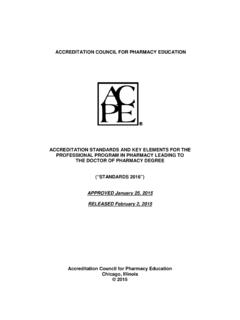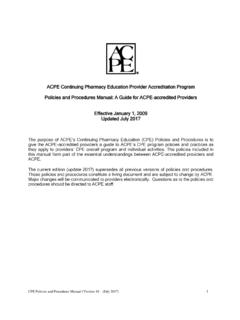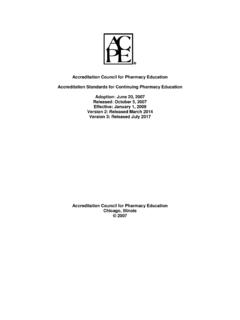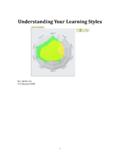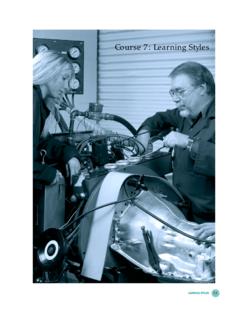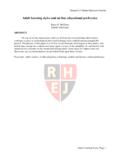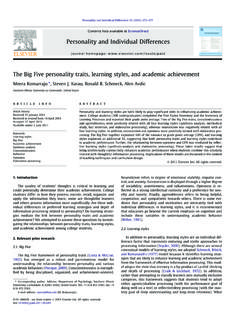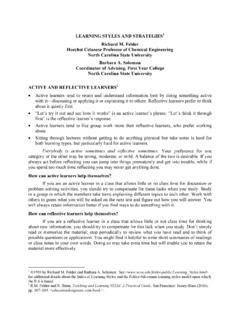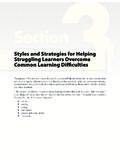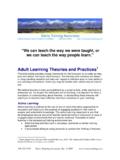Transcription of Health Professionals Inventory of Learning Styles (Zubin ...
1 4/12/20101 Health Professionals Inventory of Learning Styles (H PILS)gy()Zubin Austin PhDAssociate Dean AcademicUniversity of To r o n t o , CanadaObjectivesUpon completion of this session, you will be able to:a) Discuss the role of self reflection in CPDb)llilhf ililfb)Apply Learning Styles theory to facilitate self reflectionc) Use the H PILS to support CPDI. Self reflection in CPD CPD cycle begins with self reflection Essential skill to support identification of Learning needsilif ilii Essential propensity to facilitate on going Learning Rarely taught or evaluated in a formal way Not necessarily a natural process for manyWhat is self reflection?
2 Purposeful and directed examination of one s own behaviours, thoughts, and beliefs using a variety of different sources of evidence and criteriacriteria Analytical, continuous process Frequently aimed at quality improvement or process refinementWhy is self reflection important? Throughout school, we can rely upon external standards and assessments to direct our development Professionalworkiscomplexindividualand professional work is complex, individual, and highly contextual: external standards may be difficult to find or apply In the absence of continuous self reflection, complacency developsSelf reflection and self assessment Require on going discipline and structure Require honesty and openness Documentation We don t know what we don t know.
3 Need to triangulate and solicit information from a variety of sources, but integrate this information ourselves4/12/20102 How good are we at it? Accuracy of self reflection and self assessment varies widely Over estimation of self common in those with lowestabilitieslowest abilities Under estimation of self common in those with highest abilitiesSelf reflection A knowledge base A skill set A propensityII. Role of Learning Styles Theory in Self ReflectionHow do we learn? Behavioural approaches emphasize rewards and punishments CognitiveapproachesemphasizesupremacyCog nitive approaches emphasize supremacy of thought and reason Developmental approaches emphasize importance of age, stage, and time Psychoanalytic approaches help make the unconscious consciousLearning Styles Theory Piaget: children are born different Eysenk: the biological basis of Learning Kolb: Learning stylesLearning and Memory Working memory Short term memory Long term memory Deep Learning Superficial learningHow do we learn?
4 Intersection of two interdependent processes: How we take in information from the outside worldhdihhifi What we do with that information once we ve taken it all in4/12/20103 Learning StylesACTINGA ccommodatorDivergerDOINGWATCHINGC onvergerAssimilatorREFLECTINGD ivergers Let s just all get along together, okay? Value harmony and relationships over objective outcomes of success Maynotnecessarilygraspdetailsortimelines May not necessarily grasp details or timelines Are acutely sensitive to environment and negative feedback Enjoy working with others for the purpose of building relationships this is how Learning really occursAssimilators Lack of planning on your part is no reason for an emergency on my part Organized, detailed oriented, learn by reading and lectures.
5 Model students Require rehearsal time, advanced notice, structure and organization May confuse others confidence for competence Usually hardest on themselvesConvergers Relax everyone, I m here to help Te n d to be decisive, leader oriented, competitive individuals LessconcernedwithdetailsmorewithLess concerned with details, more with outcomes Less concerned with personal feelings than with success May confuse their own confidence with competenceAccommodators A r e we there yet? Value efficiency, sometimes at the price of effectiveness Require or want little direction or feedbackNbd dbdffidil Not burdened by need for perfection or detail Like to get things done Grow impatient with the abstract and the theoretical Dislike excessive feedback, talking, or unnecessary interactionIII.
6 H PILS Health Professionals Inventory of Learning Styles Tool developed to assist Health Professionals identifytheirownlearningstyletohelpident ify their own Learning style to help facilitate self reflection Initially developed for pharmacists, now used in a variety of different heath professions and interprofessional settings4/12/20104 Using the HPILS Self reflection may not come easily or naturally to everyone CPD requires individuals to assume personal responsibility for self identification of Learning needs and gaps Getting started can be difficult because we don t know what we don t know Understanding ourselves as learners is a critical first step in understanding our own Learning needsUsing the HPILS HPILS provides us with insight into who we are as learners.
7 What motivates us, frustrates us, inspires us, and disengages us Understanding and articulating these factors ggcan help direct the type of Learning that may be most motivating and meaningful for us As an increasing array of CE resources become available, understanding what may be most beneficial is criticalLimitations of the HPILS Inventory approach produces acceptable reliability and validity, but not able to diagnose Learning Styles Learning style is not like blood type: it is more gyypfluid and flexible Still, may be useful in prompting reflection and dialogue about our own assumptions about Learning as teachers, students, and practitionersIV.
8 Using HPILS in CPD Goal is to facilitate self reflection While HPILS does not address content/knowledge domain Learning needs andgapsitcanbeusefulinidentifyingand gaps, it can be useful in identifying Learning process needsHow to use HPILS To initiate dialogue, discussion, and reflection on the process of Learning To provide a vocabulary for discussing Learning needsneeds To provide a skill set for self reflecting on learningHow NOT to use HPILS To stereotype and pigeon hole people To make statements/claims or assumptions regarding an individual s abilities or suitability foraposition/rolefor a position/role To engineer relationships between people of the same Learning style4/12/20105 Presenting the HPILS A tool for self reflection Particularly useful for preceptors/mentors and students.
9 To help understand when things workwellandnotsowellwork well and not so well A vehicle for understanding differences in approaches to Learning , work, life, etc. A fun and interactive way of thinking about and discussing learningV. Applications of HPILS Student/preceptor relationships Workplaces Interprofessional settings CPDS ummary Self reflection is integral to the CPD process HPILS may provide a vehicle for discussing and reflecting upon one s own processes for learningg By providing a vocabulary to describe Learning processes, HPILS can be part of a toolkit for CPD providers, educators, and others interested in personal and professional developmentAbout HPILS HPILS was developed by Zubin Austin at the Faculty of Pharmacy, University of To r o n t o.
10 HPILS may be used by educators, with permissionofthedeveloperatpermission of the developer, at

